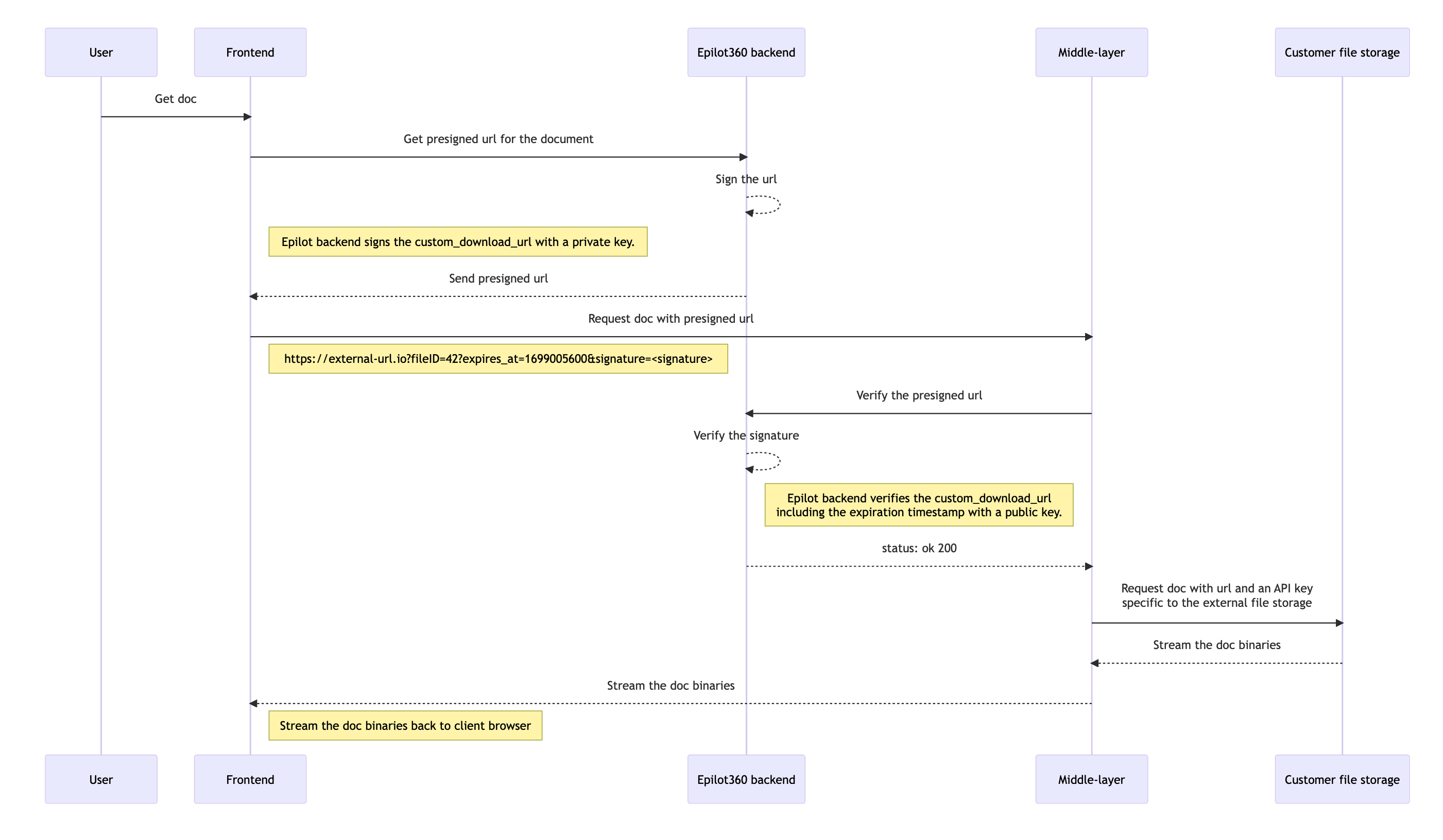File API
Files in epilot are uploaded and managed through the File API.
Downloading Files
The downloadFile operation returns a temporary presigned S3 URL, which the client uses to download a file using the GET method.
GET https://file.sls.epilot.io/v1/files/4ffdc191-f32c-404a-8520-c403b7408afa/download
{
"download_url": "https://epilot-prod-user-content.s3.eu-central-1.amazonaws.com/66/3fe52f11-89d8-4482-a102-b060e9c4b328/Snapshot_202205147_140500.jpg?X-Amz-Algorithm=AWS4-HMAC-SHA256&X-Amz-Credential=ASIA5AGXFWQOZC655PER%2F20240307%2Feu-central-1%2Fs3%2Faws4_request&X-Amz-Date=20240307T130430Z&X-Amz-Expires=900&X-Amz-Security-Token=IQoJb3JpZ2..."
}
The download_url in the response is valid for 15 minutes and can be used to download the file using the GET method.
info
The downloadFile operation requires a valid access token to be present in the request.
note
The public_url property of a file entity may also be used to download a file directly if the file is public. However the downloadFile operation works for both public and private files and is the recommended way to download files.
Uploading Files
The uploadFile operation returns a temporary presigned S3 URL, which the client uses to upload a file using the PUT or POST method.
After uploading, the client should call the saveFileV2 operation to save the uploaded file as an entity make it permanent.
Files that are uploaded but not saved expire and are deleted within 24 hours.
info
The uploadFileV2 operation requires a valid access token to be present in the request. Use the uploadFilePublic operation to upload files for Submissions of public journeys.
Example Upload Flow
Step 1: Call uploadFile to receive s3ref
POST https://file.sls.epilot.io/v2/files/upload
Body (application/json):
{
"filename": "example.pdf",
"mime_type": "application/pdf"
}
Response (201):
{
"s3ref": {
"bucket": "epilot-prod-user-content",
"key": "123/temp/f5e1c2be-7392-4a0d-8c45-236743423733/example.pdf"
},
"upload_url": "https://epilot-prod-user-content.s3.eu-central-1.amazonaws.com/123/temp/f5e1c2be-7392-4a0d-8c45-236743423733/example.pdf?X-Amz-...",
"public_url": "https://epilot-prod-user-content.s3.eu-central-1.amazonaws.com/123/temp/f5e1c2be-7392-4a0d-8c45-236743423733/example.pdf"
}
Step 2: Upload your file using a PUT request
Use the returned upload_url to upload your file to S3.
Hint: Make sure your Content-Type request header is set correctly!
PUT https://epilot-prod-user-content.s3.eu-central-1.amazonaws.com/123/temp/f5e1c2be-7392-4a0d-8c45-236743423733/example.pdf?X-Amz-...
Body (application/pdf):
(binary data)
Response (201):
(empty)
Step 3: Call saveFileV2 to persist the file and create a File entity
POST https://file.sls.epilot.io/v2/files
Body (application/json):
{
"s3ref": {
"bucket": "epilot-prod-user-content",
"key": "123/temp/f5e1c2be-7392-4a0d-8c45-236743423733/example.pdf"
},
"filename": "example.pdf",
"access_control": "private"
}
Response (201):
{
"_id": "ef7d985c-2385-44f4-9c71-ae06a52264f8",
"filename": "example.pdf",
"access_control": "private",
"public_url": "...",
"type": "document",
"mime_type": "application/pdf",
"size_bytes": 0,
"versions": [
...
]
}
Note that the public_url property of the File entity is still present in the response, even if the entity has access_control set to private. For private the public URL is simply not accessible and will return a 403 response.
You can now attach the returned file entity id to your business entity as a relation to any attribute of type file, or the default _files attribute:
{
"_schema": "opportunity",
// ...other entity fields
"_files": {
"$relation": [
{ "entity_id": "ef7d985c-2385-44f4-9c71-ae06a52264f8" }
]
}
}
External Files
In some cases, storing files on the epilot side is undesirable. For instance, when it would mean migrating a large document archive. In such scenarios, it is possible to skip the upload steps and utilize the custom_download_url property when saving a File entity.
POST https://file.sls.epilot.io/v2/files
Body (application/json):
{
"custom_download_url": "https://external-url.io?fileID=42",
"filename": "example.pdf",
"access_control": "private"
}
Response (201):
{
"_id": "ef7d985c-2385-44f4-9c71-ae06a52264f8",
"filename": "example.pdf",
"access_control": "private",
"custom_download_url": "https://external-url.io?fileID=42",
"type": "unknown",
"size_bytes": 0,
"versions": [
...
]
}
External files are then retrieved on the fly from epilot with a short-lived signature and streamed directly to the end user.
To verify the request is coming from epilot, use the verifyCustomDownloadUrl operation.

info
Requests to download external files come from the user's browser. All data from the response (including headers) can be viewed by the end user and as such should not contain any sensitive data, like internal tokens, apart from the file.
Updating Files
Modifying or saving new versions of File entities happens via the saveFileV2 operation.
Deleting Files
Deleting files is done using the deleteFile operation. When the file entity is deleted, the underyling S3 object is deleted permanently.